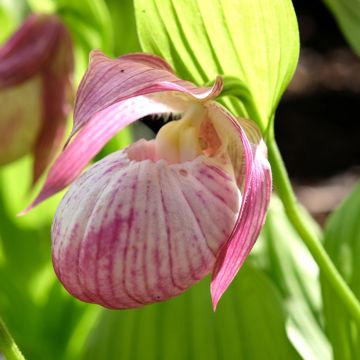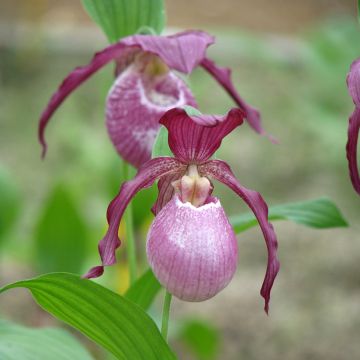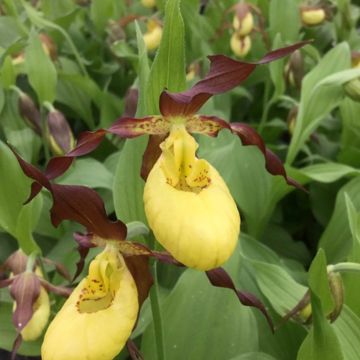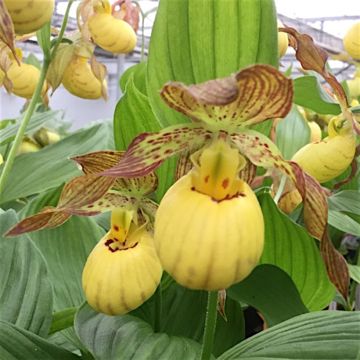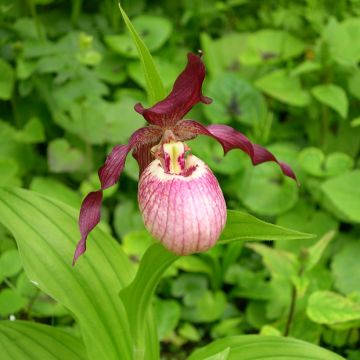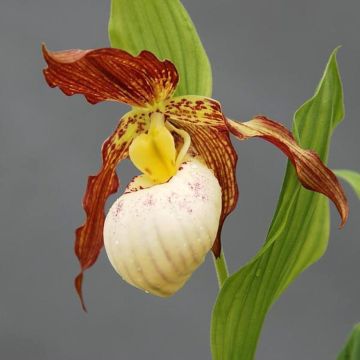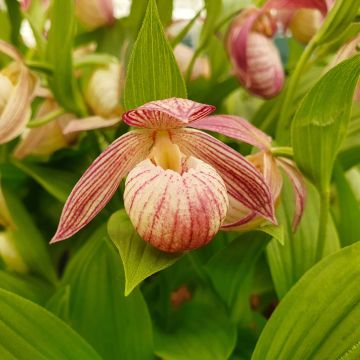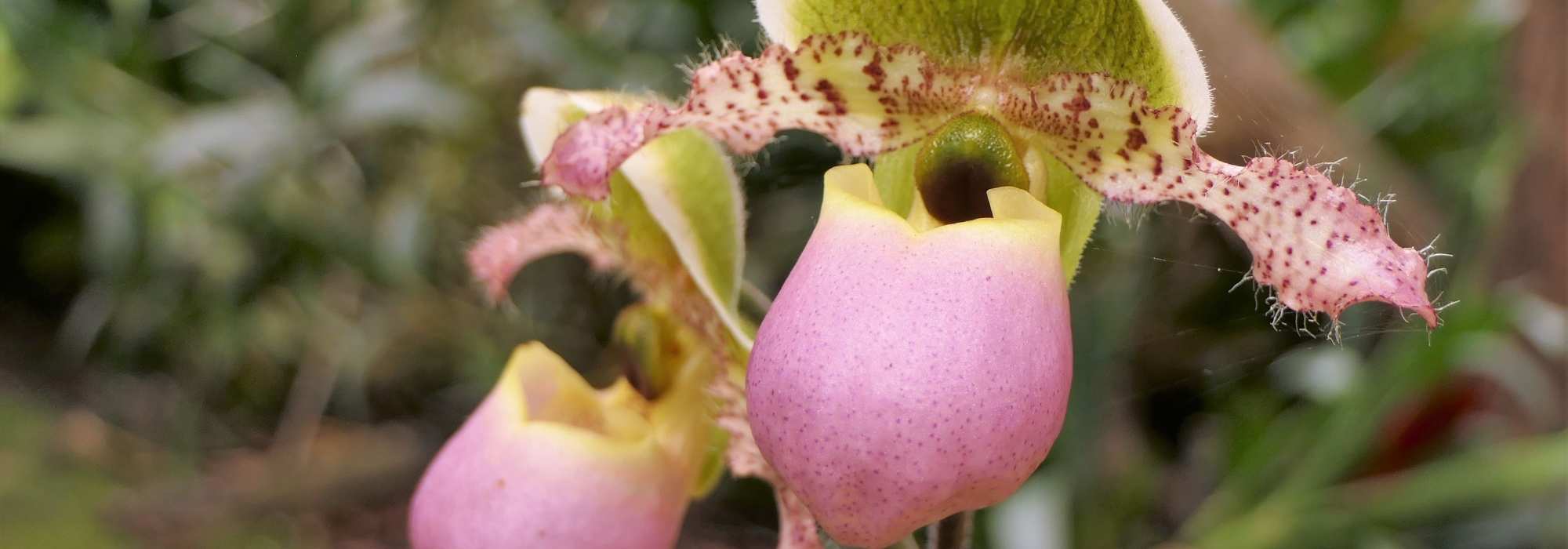
Cypripedium - Lady's slipper orchid: planting and growing
Contents
Cypripediums in a nutshell
- Cypripediums are hardy perennial orchids
- Lady’s slippers bloom from May to June
- The flowers are stunning and spectacular
- Slowly but surely, cypripediums eventually form a beautiful colony
- They are grown in partial shade in poor, cool, but well-drained soil
The word from our expert
Cypripediums, more commonly known as “Venus slippers”, are perennial orchids for the garden. They bloom in spring, producing one to two flowers per plant. A flower typical of the genus Cypripedium features its enormous lip resembling a slipper or a shoe.
Initially reserved for specialists and collectors, Venus slippers are becoming more popular and are gradually appearing in gardens. This is particularly true for the Cypripedium reginae, probably the easiest orchid of the genus to grow. In our native flora, we also have a Cypripedium: Cypripedium calceolus or Venus slipper. However, do not attempt to grow it if you are a novice, as it is likely one of the most challenging to maintain at home.
Very hardy, these orchids are nonetheless delicate regarding their growing conditions. It is important to remember that these plants require specific conditions: a poor, cool, but well-drained soil (the required pH depends on the species), and a partially shaded exposure. If you adhere to this and ensure you have changed the substrate necessary over a minimum of one square metre per plant and 50 cm deep (yes, indeed… just that!), it should go well. Over the years, you should achieve a beautiful carpet of cypripediums. In any case, we’re keeping our fingers crossed for you!
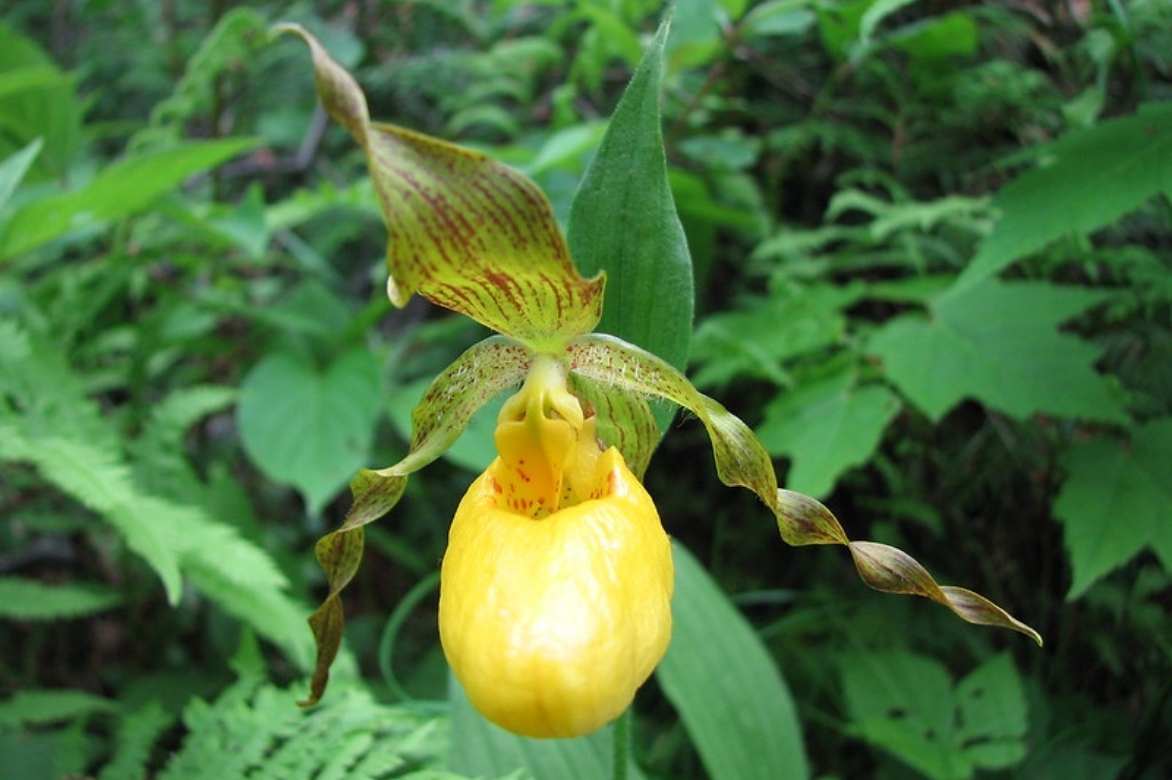
Cypripedium parviflorum
Botany and description
“`html
Botanical data
- Latin name Cypripedium sp.
- Family Orchidaceae
- Common name Cypripedium - Lady's Slipper - Venus Slipper - Cypripede - Our Lady's Slipper
- Flowering April to July (depends on species)
- Height 40 to 80 cm
- Sun exposure partial shade
- Soil type humus-bearing, cool but well-drained
- Hardiness -15°C
The genus Cypripedium belongs to the family of orchids and includes around forty species, of which only one grows in Europe: Cypripedium calceolus or Venus Slipper. The other Cypripediums grow in North America, Mexico, and Southeast Asia. Here is a short list of some of the most well-known: Cypripedium reginae, Cypripedium smithii, Cypripedium tibeticum, Cypripedium japonicum, Cypripedium kentuckiense, Cypripedium montanum, Cypripedium californicum, Cypripedium flavum, Cypripedium formosanum, Cypripedium acaule, Cypripedium parviflorum or Cypripedium candidum.
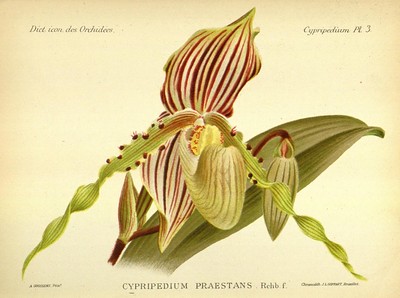
Cypripedium praestans, botanical plate (circa 1898)
Please note that Cypripedium reginae seems to be the easiest to cultivate in the garden. Hybrid cypripediums are also easier to grow, such as Cypripedium ‘Ulla Silkens’, for example, a hybrid between Cypripedium reginae and Cypripedium flavum. Paradoxically, Cypripedium calceolus, although native to our flora, is nearly impossible to cultivate here. Moreover, due to climate change, its distribution area is increasingly moving north in Europe or to higher altitudes in our mountains.
Cypripediums or Venus Slippers are terrestrial orchids, meaning they live on the ground. They grow on a rootstock that spreads over the seasons, allowing the plant to cover a large area. The life cycle of the Venus Slipper can be summarised as follows:
- March-April: the plant awakens and starts to grow leaves. These develop in just 3 to 5 weeks;
- May-June: flowering of the orchids
- August-September: leaf fall, the leaves yellow and then die;
- October-December: growth of the next shoot for the following year;
- December-February: dormancy of the plant and death of the old shoot, the one that flowered the previous year.
The foliage is deciduous, meaning it dies and disappears in winter. The leaves are green, broad, and plicate.
Flowering occurs in spring, from May to June for most. Each shoot will produce one to two flowers on the same flower spike. The flowers of this botanical genus are easily recognised by the slipper or shoe shape: the large hollow labellum of the flower. The flowers consist of 3 sepals and 3 petals: the 3 sepals and the 2 lateral petals are more or less narrow, while the central petal is very broad: this famous labellum. Its main function is to attract the pollinating insect to the flower.
Once pollinated, the flower transforms into fruit: an upright capsule in the shape of a spindle containing many tiny seeds. However, cypripediums primarily multiply vegetatively (asexually), by suckering via the rootstock.
Cypripediums are generally very hardy. They can sometimes withstand temperatures as low as -30°C, provided the substrate is suitable (see planting point). Therefore, it is unnecessary to protect them in winter.
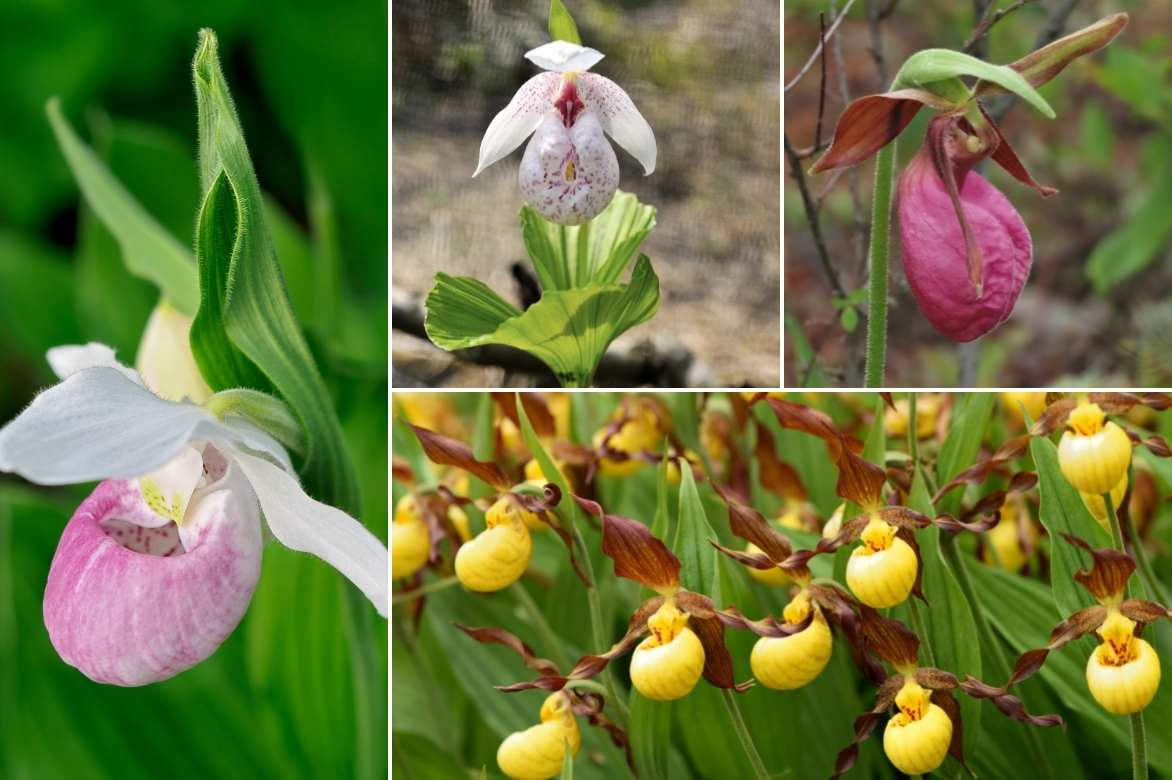 Cypripedium reginae (left), Cypripedium formosanum (top middle), Cypripedium acaule (top right), and Cypripedium calceolus below
Cypripedium reginae (left), Cypripedium formosanum (top middle), Cypripedium acaule (top right), and Cypripedium calceolus below
Nota bene: almost all species of cypripediums are endangered in their natural habitats. The causes? Habitat destruction, certainly, but not only that. A large number of unscrupulous collectors or traffickers do not hesitate to uproot them from the wild to resell or replant them at home. Be sure to check the certification and origin of your orchids before purchasing! They should be sourced from in vitro cultivation. Orchids from in vitro cultivation have young, short, and entire rootstocks, while orchids taken from the wild have long, thick, and often damaged rootstocks. Let us not contribute to the decline of these species! Moreover, it is utterly foolish: a plant taken from its natural habitat will die very quickly in the garden, as it has been uprooted without its symbiotic fungus, which it needs to survive.
“`
Read also
Calanthe: planting and growingOur finest species and varieties
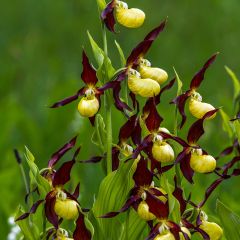
Cypripedium calceolus
- Flowering time June to August
- Height at maturity 40 cm
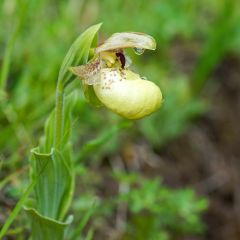
Cypripedium flavum
- Flowering time July, August
- Height at maturity 50 cm
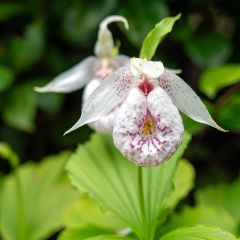
Cypripedium formosanum
- Flowering time May, June
- Height at maturity 40 cm
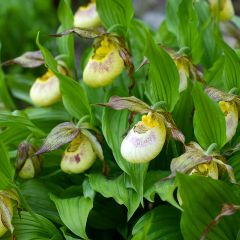
Cypripedium kentuckiense
- Flowering time June, July
- Height at maturity 80 cm
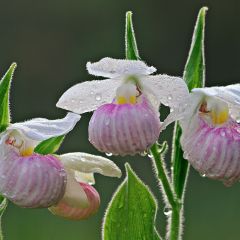
Cypripedium reginae
- Flowering time July, August
- Height at maturity 70 cm
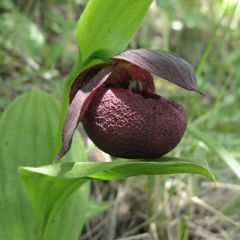
Cypripedium smithii
- Flowering time May, June
- Height at maturity 40 cm
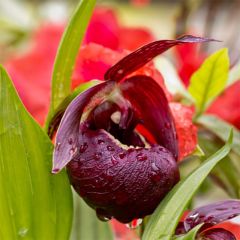
Cypripedium tibeticum
- Flowering time June, July
- Height at maturity 30 cm
Discover other Cypripedium
View all →Available in 1 sizes
Available in 1 sizes
Available in 1 sizes
Available in 1 sizes
Available in 1 sizes
Available in 1 sizes
Available in 1 sizes
Available in 1 sizes
Available in 1 sizes
Available in 1 sizes
Planting a Cypripedium
Where to Plant a Lady’s Slipper?
Partial shade is the best exposure, sheltered from large deciduous trees. Too much sun will scorch the foliage, and too much shade will prevent the orchid from flowering. Orient the plant towards the South-East or West/South-West.
Regarding the soil, it should be neutral to slightly calcareous, cool, even moist all year round, but well-drained. The soil should also be as low in fertility as possible (except for Cypripedium parviflorum). Poor soil closely resembles their natural habitat. In other words, a substrate of: 1/3 coarse sand + 1/3 leaf mould + 1/3 garden clay soil would be a good option.
Some Cypripediums prefer acidic soil, notably Cypripedium acaule, which grows in turf moors. In this case, you should replace the sand with sphagnum moss.
Certain Lady’s Slippers can be kept in pots for two or three years. This is the case for Cypripedium japonicum, C. smithii, and C. formosanum. However, planting in the ground is still largely preferable.
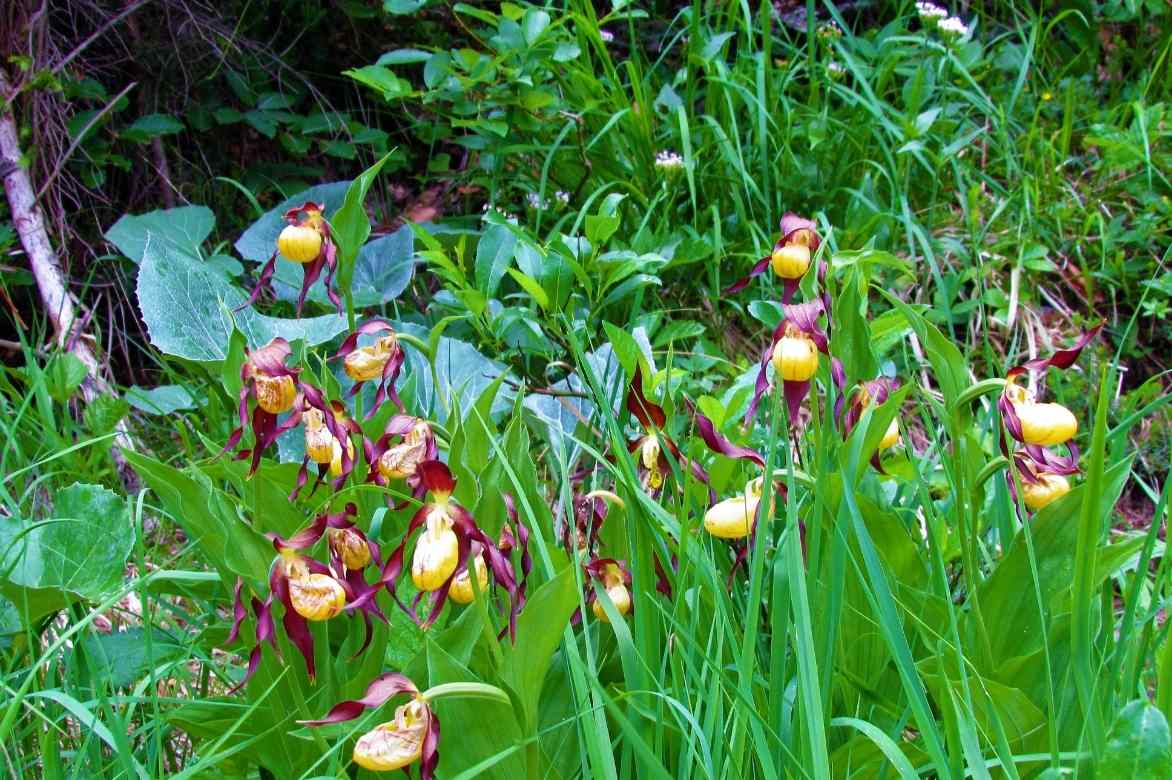
Cypripedium calceolus
When to Plant?
Plant your Cypripediums at the beginning of spring (April). This way, your orchid will have time to create its next annual shoot before winter.
How to Plant a Cypripedium?
Ideally, plant these orchids in groups of about ten for 6 m², spacing them at least 30 cm apart. Cypripediums multiply by extending their rhizomes laterally. But, be careful! Even for a single plant, you will need to prepare the soil over at least one square metre.
- Dig a square metre to a depth of 50 cm;
- Place a drainage layer at the bottom: pumice, gravel, lava rock… about ten centimetres thick;
- Fill the entire hole with a mixture of 1/3 sand, 1/3 leaf mould, and 1/3 garden clay soil;
- Plant your orchids with the substrate from the pot. Do not remove it! as it contains the symbiotic fungus that the plant needs to survive;
- Be careful to keep the collar above the soil surface;
- Water thoroughly as with any planting: providing moisture, but especially eliminating any “air pockets” between the substrate and the roots.
Cultivation and Care of Cypripedium
No fertiliser!: Venus slippers prefer poor soils.
Water during dry spells with rainwater if possible.
Maintenance consists of cutting the flower spike to 5 cm as soon as it wilts. This way, the orchid will avoid wasting energy unnecessarily. You can also either cut the leaves back to 5 cm at the start of leaf drop, or wait until they turn brown (and thus dead) and remove them by hand at the end of the season.
After a few years of cultivation, if all goes well, the cypripediums will have colonised your initial area. At this point, you should consider expanding the area using the same technique as mentioned above. This means digging to 50 cm, placing a drainage layer, and then filling the hole with the appropriate substrate.
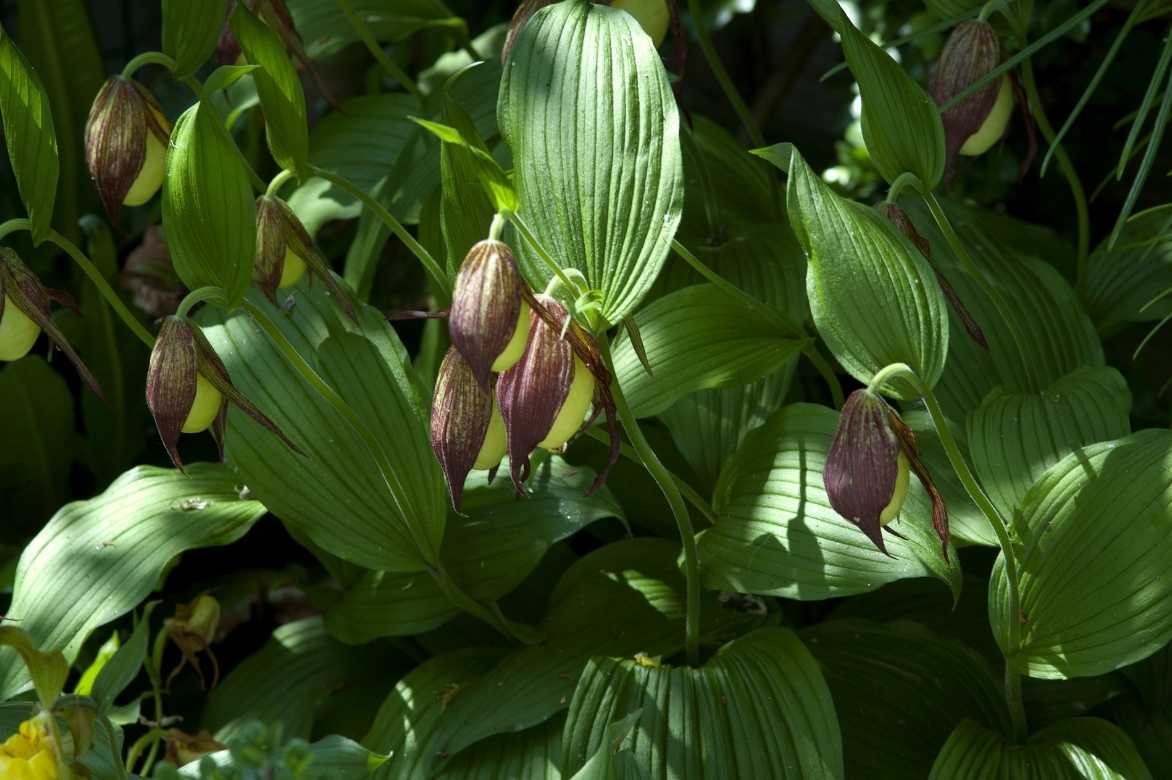
Cypripedium kentuckiense
Diseases and potential pests
If the growing conditions are met, everything should go well. No disease or pest generally disrupts orchids. Leaf necrosis (brownish spots and soft leaves) is often a sign of poor placement (not enough light) or a drainage issue.
Multiplication of Cypripedium
In our region, different species of Cypripedium cannot reproduce by sowing. Indeed, for their flowers to be fertilised, these orchids require a specific insect that is dependent on each species. These specific insects are only found in their natural habitats. Furthermore, each orchid species lives in sym symbiosis with a fungus present in the soil. If this fungus is not present, the orchid will not survive for a year. This fungus is “provided” in the substrate of the pots of the cypripediums offered for sale.
Otherwise, these orchids naturally multiply over the years by suckering. In the first few years (3 to 5 years), each cypripedium will create a single new shoot to replace the old one. However, after this period, the lady’s slippers will be able to produce two new shoots (very rarely more) each year.
Division will then be possible, but delicate, by cutting a piece of rootstock in April with a shoot from the year. It will simply need to be transplanted elsewhere, but in an area that has been previously prepared to accommodate lady’s slippers (see planting section).
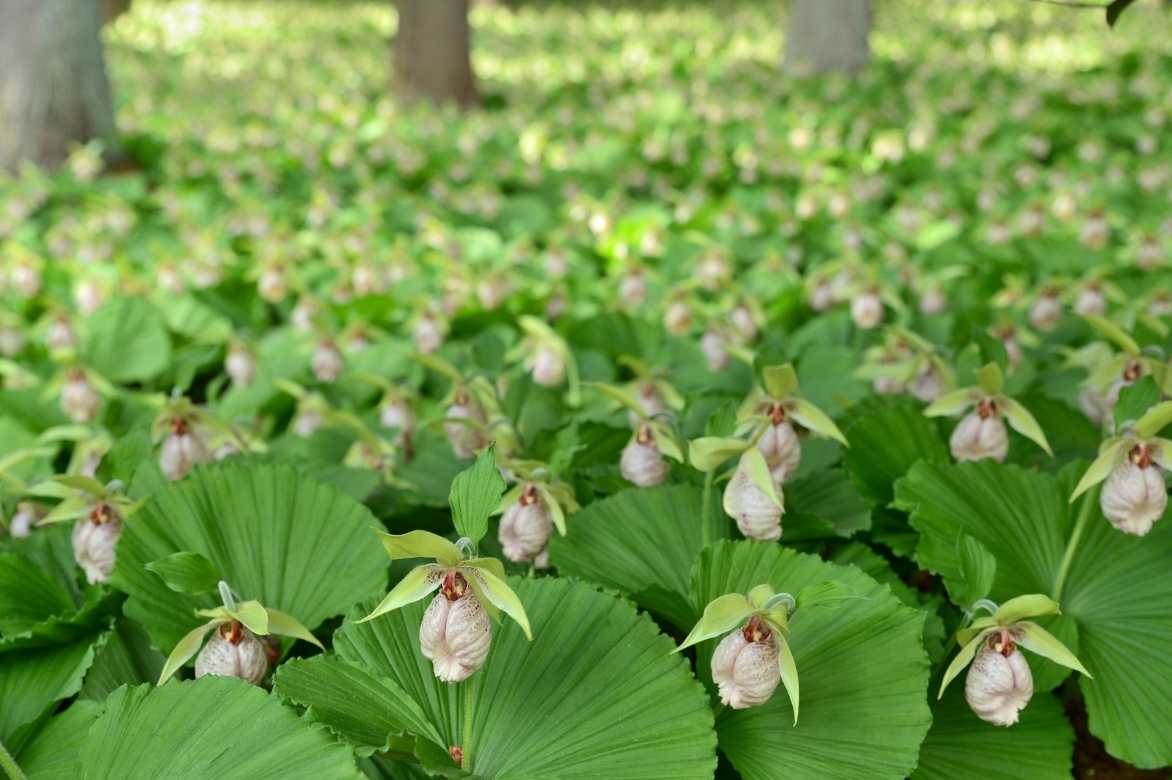
The Cypripedium japonicum has an astonishing fan-shaped foliage, here forming a sublime carpet
How to pair your Cypripediums?
Plant cypripediums in shade within a cool rockery among stones or at the edge of a cool woodland. These orchids are self-sufficient, so we will aim for a simple accompaniment. Let’s choose the easiest to grow and ultimately one of the most beautiful: the Royal Lady’s Slipper or Cypripedium reginae. We will pair it with perennials that thrive in a cool woodland atmosphere in well-drained, poor, and slightly calcareous soil.
Several ferns are suitable for this type of soil and exposure: the classic Polypodium vulgare, which will quickly form colonies of evergreen fronds, as well as the lesser-known Anemia mexicana, the “flowering” fern from Mexico (it doesn’t produce true flowers, of course!).
For flowering, a few Lamium orvala will have the good taste to bloom at the same time as the cypripediums. In fact, the flower of lamium somewhat resembles those of orchids. Even if the soil is a bit calcareous, Brunnera macrophylla ‘Jack Frost’ will be perfect as a groundcover.
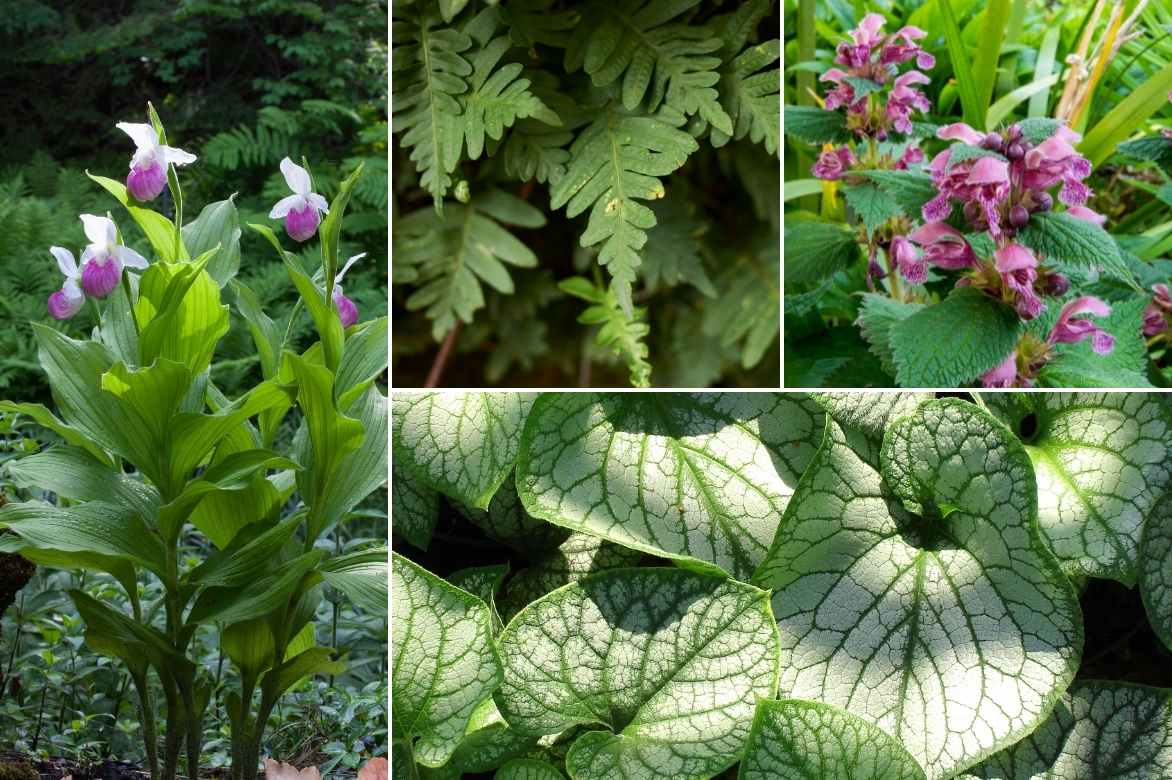
Cypripedium reginae, Polypodium vulgare, Lamium orvala and Brunnera macrophylla ‘Jack Frost’
→ Discover more association ideas with Cypripedium in our advice sheet!
Did you know?
- The genus name “Cypripedium” comes from Greek and Latin. From “Cypria,” a nickname for Venus, and “Pedion,” which means “slipper” in Greek. So “Venus’s slipper” or more commonly “Lady’s slipper”;
- To be precise, the genus Cypripedium belongs to the subfamily Cypripedioideae (feel free to try it at Scrabble!);
- In the past, the genus Cypripedium was broader. Recent revisions in botanical classification have removed tropical species and classified them into other genera: Paphiopedilum, Phragmipedium, Mexipedium, and Selenipedium;
- The leaves of Cypripediums contain calcium oxalate, which is harmful to some soil fauna. Therefore, do not add them to compost;
- The showy lady’s slipper or Cypripedium reginae is covered in a fine down inhabited by a fungus on all parts of the plant. This down can cause contact dermatitis and eczema.
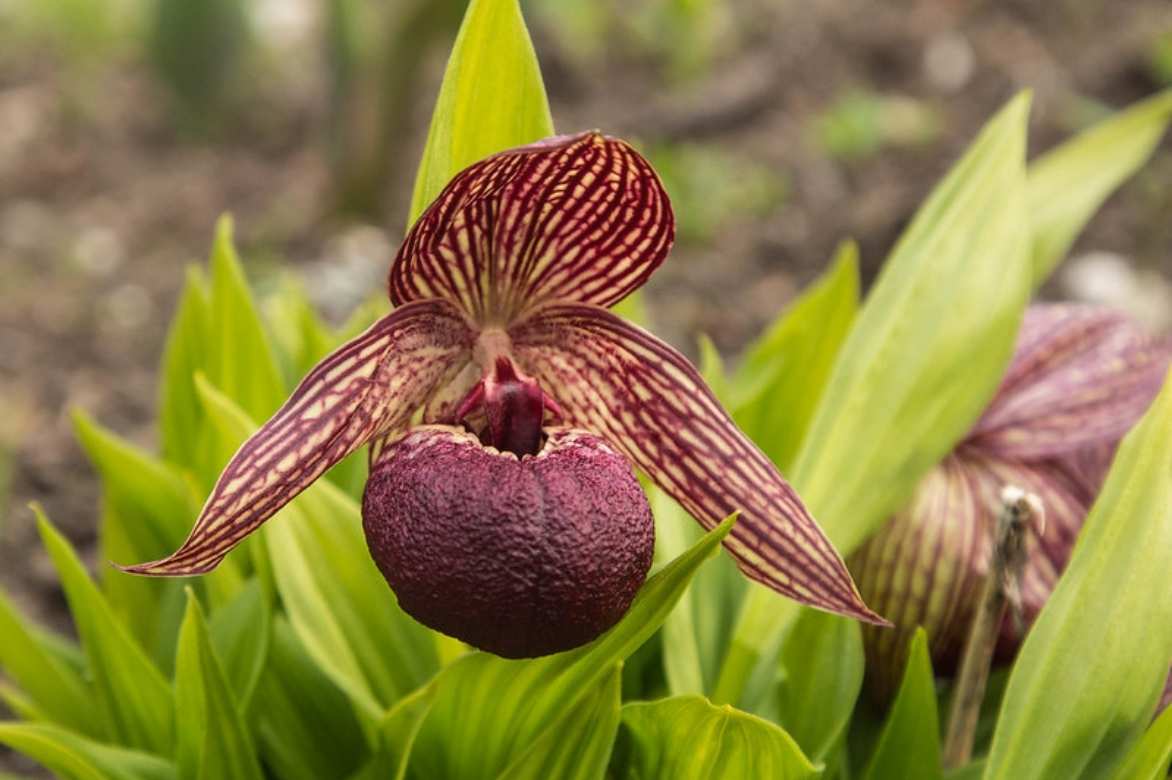
Cypripedium tibeticum (© Sara@Shotley)
Useful resources
→ Find all our cypripediums in our online nursery.
Discover hardy orchids to grow in the garden!
Feel free to check our comprehensive guides for growing Calanthes, Bletillas, Pleiones, and Dactylorhiza.
- Subscribe!
- Contents































